Abstract
The main aim of the paper is to give the crossing number of the join product for the disconnected graph G of order five consisting of one isolated vertex and of one vertex incident with some vertex of the three-cycle, and consists of n isolated vertices. In the proofs, the idea of the new representation of the minimum numbers of crossings between two different subgraphs that do not cross the edges of the graph G by the graph of configurations in the considered drawing D of will be used. Finally, by adding some edges to the graph G, we are able to obtain the crossing numbers of the join product with the discrete graph and with the path on n vertices for three other graphs.
1. Introduction
The investigation of the crossing number of graphs is a classical and very difficult problem provided that computing of the crossing number of a given graph in general is an NP-complete problem. It is well known that the problem of reducing the number of crossings in the graph has been studied in many areas, and the most prominent area is very large-scale integration technology.
In the paper, we will use notations and definitions of the crossing numbers of graphs like in []. We will often use Kleitman’s result [] on crossing numbers of the complete bipartite graphs. More precisely, he proved that:
Using Kleitman’s result [], the crossing numbers for join of two paths, join of two cycles, and for join of path and cycle were studied in []. Moreover, the exact values for crossing numbers of and for all graphs G of order at most four are given in []. Furthermore, the crossing numbers of the graphs are known for a few graphs G of order five and six in [,,,,,,]. In all of these cases, the graph G is connected and contains at least one cycle. Further, the exact values for the crossing numbers and have been also investigated for some graphs G of order five and six in [,,,].
The methods presented in the paper are new, and they are based on multiple combinatorial properties of the cyclic permutations. It turns out that if the graph of configurations is used like a graphical representation of the minimum numbers of crossings between two different subgraphs, then the proof of the main theorem will be simpler to understand. Similar methods were partially used for the first time in the papers [,]. In [,,,], the properties of cyclic permutations were also verified with the help of software in []. In our opinion, the methods used in [,,] do not allow establishing the crossing number of the join product .
2. Cyclic Permutations and Configurations
Let G be the disconnected graph of order five consisting of one isolated vertex and of one vertex incident with some vertex of the three-cycle. We will consider the join product of the graph G with the discrete graph on n vertices denoted by . The graph consists of one copy of the graph G and of n vertices , where any vertex , , is adjacent to every vertex of G. Let , , denote the subgraph induced by the five edges incident with the vertex . Thus, the graph is isomorphic with the complete bipartite graph and:
In the paper, we will use the same notation and definitions for cyclic permutations and the corresponding configurations for a good drawing D of the graph like in [,]. Let D be a drawing of the graph . The rotation of a vertex in the drawing D like the cyclic permutation that records the (cyclic) counter-clockwise order in which the edges leave has been defined by Hernández-Vélez, Medina, and Salazar []. We use the notation if the counter-clockwise order the edges incident with the vertex is , , , , and . We have to emphasize that a rotation is a cyclic permutation. In the paper, each cyclic permutation will be represented by the permutation with one in the first position. Let denote the inverse permutation of . We will deal with the minimal necessary number of crossings between the edges of and the edges of in a subgraph depending on the rotations and .
We will separate all subgraphs , , of the graph into three mutually-disjoint subsets depending on how many of the considered cross the edges of G in D. For , let and . Every other subgraph crosses the edges of G at least twice in D. Moreover, let denote the subgraph for , where . Thus, for a given subdrawing of G, any subgraph is exactly represented by .
Let us suppose first a good drawing D of the graph in which the edges of G do not cross each other. In this case, without loss of generality, we can choose the vertex notation of the graph in such a way as shown in Figure 1a. Our aim is to list all possible rotations that can appear in D if the edges of do not cross the edges of G. Since there is only one subdrawing of represented by the rotation , there are two possibilities for how to obtain the subdrawing of depending on in which region the edge is placed. Of course, the vertex can be placed in one of four regions of the subdrawing with the vertex on their boundaries. These possibilities under our consideration will be denoted by and , for and . The configuration is of type A or B in the considered drawing D, if the vertex is placed in the quadrangular or in the triangular region in the subdrawing , respectively. As for our considerations, it does not play a role in which of the regions is unbounded; assume the drawings shown in Figure 2. Thus, the configurations , , , , , , , and are represented by the cyclic permutations , , , , , , , and , respectively. In a fixed drawing of the graph , some configurations from need not appear. We denote by the subset of consisting of all configurations that exist in the drawing D.
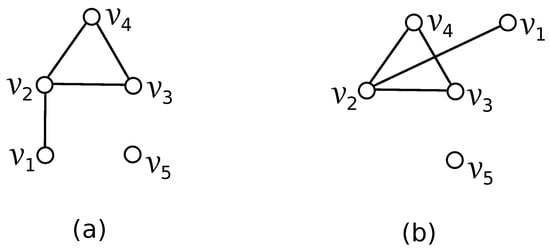
Figure 1.
Two good drawings of the graph G. (a): the planar drawing of G; (b): the drawing of G with crD(G) = 1.
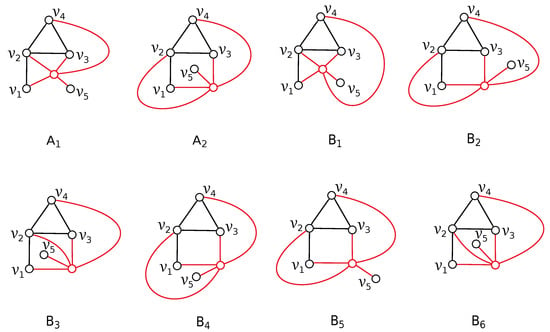
Figure 2.
Drawings of eight possible configurations from of the subgraph .
We remark that if two different subgraphs and with their configurations from cross in a considered drawing D of the graph , then the edges of are crossed only by the edges of . Let X, Y be the configurations from . We briefly denote by the number of crossings in D between and for two different such that , have configurations X, Y, respectively. Finally, let over all good drawings of the graph with . Our aim shall be to establish for all pairs .
The configurations and are represented by the cyclic permutations and , respectively. Since the minimum number of interchanges of adjacent elements of required to produce cyclic permutation is one, any subgraph with the configuration of crosses the edges of at least once, i.e., . Details have been worked out by Woodall []. The same reason gives , , , , , , , and for . Moreover, by a discussion of possible subdrawings, we can verify that , , , and . Let be the subgraph having the configuration , and let be a subgraph from with . Using Woodall’s result for some nonnegative integer k, let us also suppose that . Of course, any subgraph having the configuration or satisfies the mentioned condition. One can easily see that if , then . If and , then the subdrawing induced by the edges incident with the vertices and crosses the edges of exactly once, and once, respectively. Thus, , i.e., the subgraph has the configuration . This forces and . Similar arguments are applied for and . Clearly, also and for any and . Thus, all lower bounds of the number of crossing of configurations from are summarized in the symmetric Table 1 (here, and are configurations of the subgraphs and , where are integers from or , and ).

Table 1.
The necessary number of crossings between and for the configurations , .
Assume a good drawing D of the graph with one crossing among edges of the graph G (in which there is a subgraph ). In this case, without loss of generality, we can choose also the vertex notations of the graph in such a way as shown in Figure 1b. Since there is only one subdrawing of represented by the rotation , we have four possibilities for how to obtain the subdrawing of depending on in which region the vertex is placed. Thus, there are four different possible configurations of the subgraph denoted as , , , and , with the corresponding rotations , , , and , respectively. We denote by the subset of consisting of all configurations that exist in the drawing D. The same way as above can be applied for the verification of the lower bounds of the number of crossings of two different configurations from . Thus, all lower bounds of the numbers of crossings of two configurations from are summarized in the symmetric Table 2 (here, and are configurations of the subgraphs and , where ).

Table 2.
The necessary number of crossings between and for the configurations , .
3. The Graph of Configurations
In general, the low possible number of crossings between two different subgraphs in a good subdrawing of is one of the main problems in the proofs on the crossing number of the join of the graph G with the discrete graphs . The lower bounds of the numbers of crossings between two subgraphs, which do not cross the edges of G, were summarized in the symmetric Table 1. Since some configurations from the set need not appear in the fixed drawing of , we will first deal with the smallest possible values in Table 1 as with the worst possible case in the mentioned proofs. Thus, a new graphical representation of Table 1 by the graph of configurations will be useful.
Let us suppose that D is a good drawing of the graph with , and let be the nonempty set of all configurations that exist in the drawing D belonging to the set . A graph of configurations is an ordered triple , where is the set of vertices, is the set of edges, which is formed by all unordered pairs of distinct vertices, and a weight function that associates with each edge of an unordered pair of two vertices of . The vertex for some if the corresponding configuration for some , where or . The edge if and are two different vertices of the graph . Finally, for the edge , if m is the associated lower bound between two different configurations , and in Table 1. Of course, is the simple undirected edge-weighted graph uniquely determined by the drawing D. Moreover, if we define the graph in the same way over the set , then is the subgraph of induced by for the considered drawing D. Since the graph can be represented like the edge-weighted complete graph , it will be more transparent to follow the subcases in the proof of the main theorem; see Figure 3.
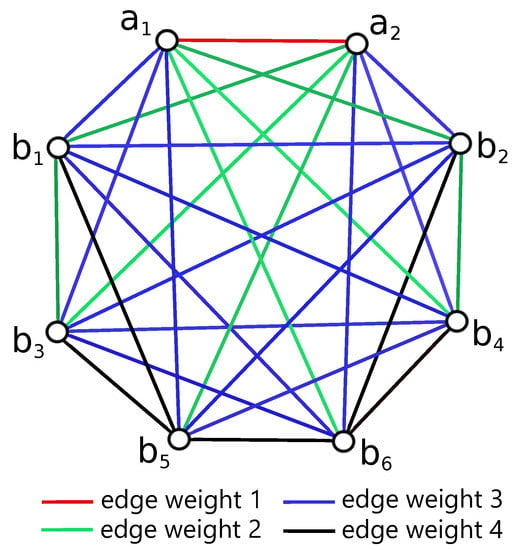
Figure 3.
Representation of the lower bounds of Table 1 by the graph .
4. The Crossing Number of
Two vertices and of are antipodal in a drawing of if the subgraphs and do not cross. A drawing is antipodal-free if it has no antipodal vertices. In the rest of the paper, each considered drawing of the graph will be assumed antipodal-free. In the proof of the main theorem, the following lemma related to some restricted subdrawings of the graph is helpful.
Lemma 1.
Let D be a good and antipodal-free drawing of , . If are different subgraphs such that , have different configurations from any of the sets , , , and , then:
Proof of Lemma 1.
Let us suppose the configuration of the subgraph , and note that it is exactly represented by . The unique drawing of the subgraph contains four regions with the vertex on their boundaries (Figure 2). If there is a with , then one can easily see that . Of course, the edge must cross one edge of the graph G. If crosses the edge , then the subgraph is represented by . If the edge crosses the edge , then there are only three possibilities for the considered subdrawing of , i.e., the subgraph can be represented by three possible cyclic permutations , , or .
For the remaining configurations , , , , and of , using the same arguments, one can easily verify that the rotations of the vertex are from the sets , , , , and , respectively. This forces that there is no subgraph with , where the subgraph has the configuration or . The same reason is given for the case of with the configurations and . Finally, for any . This completes the proof. □
We have to emphasize that we cannot generalize Lemma 1 for all pairs of different configurations from . Let us assume the configurations of and of . For , the reader can easily find a subdrawing of in which . The same remark holds for pairs with , with , and with .
Theorem 1.
for .
Proof of Theorem 1.
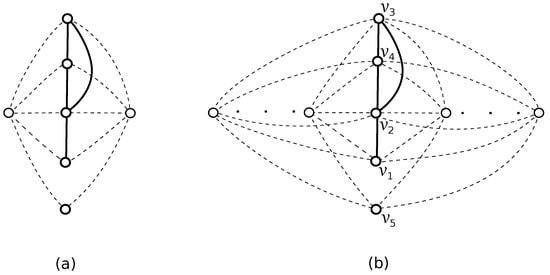
The drawing in Figure 4b shows that . We prove the reverse inequality by contradiction. The graph is planar; hence, . Since the graph contains a subdivision of the complete bipartite graph , we have . Thus, by the good drawing of in Figure 4a. Suppose now that for , there is a drawing D with:
and let

Figure 4.
The good drawings of and of . (a): the drawing of G + D2 with one crossing; (b): the drawing of G + Dn with crossings.
Let us first show that the considered drawing D must be antipodal-free. As a contradiction, suppose that, without loss of generality, . Using positive values in Table 1 and Table 2, one can easily verify that both subgraphs and are not from the set , i.e., . The known fact that implies that any , , crosses the edges of the subgraph at least four times. Therefore, for the number of crossings in the considered drawing D, we have:
This contradiction with the assumption (2) confirms that D must be an antipodal-free drawing. Moreover, if and , the assumption (3) together with the well-known fact imply that in D, there are at least subgraphs , which do not cross the edges of G. More precisely:
i.e.,
This forces that , and . Now, for , we will discuss the existence of possible configurations of subgraphs in the drawing D.
Case 1. . Without loss of generality, we can choose the vertex notation of the graph G in such a way as shown in Figure 1a. Thus, we will deal with the configurations belonging to the nonempty set . According to the minimum value of the weights of edges in the graph , we will fix one, or two, or three subgraphs with a contradiction with the condition (2) in the following subcases:
- i.
- , i.e., . Without loss of generality, let us consider two different subgraphs such that and have configurations and , respectively. Then, for any with by summing the values in all columns in the considered two rows of Table 1. Moreover, for any subgraph with due to the properties of the cyclic permutations. Hence, by fixing the graph ,
- ii.
- , i.e., for any .Let us assume that or , i.e., there is a three-cycle in the graph with weights of two of all its edges. Without loss of generality, let us consider three different subgraphs such that , m and have different configurations from . Then, for any with by Table 1, and for any subgraph by Lemma 1. Thus, by fixing the graph ,
In the next part, let us suppose that and ,
- (1)
- for some or , where . Without loss of generality, let us consider two different subgraphs such that and have configurations and , respectively. Then, for any with by Table 1. Moreover, for any subgraph with due to properties of the cyclic permutations. Hence, if we fix the graph ,
- (2)
- for any and , where , i.e., for any . Without loss of generality, we can assume that . Then, for any with . Thus, by fixing the graph ,
Case 2. . Without loss of generality, we can choose the vertex notation of the graph G in such a way as shown in Figure 1b. Thus, we will deal with the configurations belonging to the nonempty set in the following two cases:
- i.
- for some . Without loss of generality, let us consider two different subgraphs such that and have different configurations from the set . Then, for any with by Table 2. Moreover, for any subgraph with due to the properties of the cyclic permutations. Hence, by fixing the graph ,If and have different configurations from the set , then the same argument can be applied.
- ii.
- for any . Without loss of generality, we can assume that . Then, for any with . Thus, by fixing the graph ,
Thus, it was shown that there is no good drawing D of the graph with less than crossings. This completes the proof of Theorem 1. □
5. Three Other Graphs
Finally, in Figure 4b, we are able to add the edges and to the graph G without additional crossings, and we obtain three new graphs for in Figure 5. Therefore, the drawing of the graphs , , and with crossings is obtained. On the other hand, is a subgraph of each , and therefore, for any . Thus, the next results are obvious.
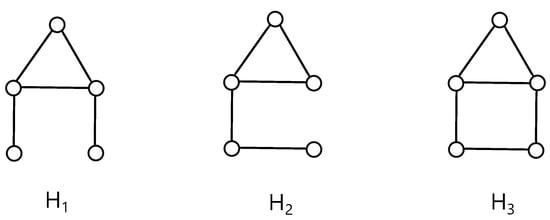
Figure 5.
Three graphs , , and by adding new edges to the graph G.
Corollary 1.
for , where .
We remark that the crossing numbers of the graphs and were already obtained by Berežný and Staš [], and Klešč and Schrötter [], respectively. Moreover, into the drawing in Figure 4b, it is possible to add n edges, which form the path , on the vertices of without another crossing. Thus, the next results are also obvious.
Theorem 2.
for .
The crossing number of the graph has been investigated in [].
Funding
This research received no external funding.
Acknowledgments
This work was supported by the internal faculty research Project No. FEI-2017-39.
Conflicts of Interest
The author declares no conflict of interest.
References
- Klešč, M. The join of graphs and crossing numbers. Electron. Notes Discret. Math. 2007, 28, 349–355. [Google Scholar] [CrossRef]
- Kleitman, D.J. The crossing number of K5,n. J. Comb. Theory 1970, 9, 315–323. [Google Scholar] [CrossRef]
- Klešč, M.; Schrötter, Š. The crossing numbers of join products of paths with graphs of order four. Discuss. Math. Graph Theory 2011, 31, 312–331. [Google Scholar] [CrossRef]
- Berežný, Š.; Staš, M. On the crossing number of the join of five vertex graph G with the discrete graph Dn. Acta Electrotech. Inform. 2017, 17, 27–32. [Google Scholar] [CrossRef]
- Klešč, M. The crossing numbers of join of the special graph on six vertices with path and cycle. Discret. Math. 2010, 310, 1475–1481. [Google Scholar] [CrossRef]
- Klešč, M.; Petrillová, J.; Valo, M. On the crossing numbers of Cartesian products of wheels and trees. Discuss. Math. Graph Theory 2017, 37, 339–413. [Google Scholar] [CrossRef]
- Klešč, M.; Schrötter, Š. The crossing numbers of join of paths and cycles with two graphs of order five. In Lecture Notes in Computer Science: Mathematical Modeling and Computational Science; Springer: Berlin/Heidelberg, Germany, 2012; Volume 7125, pp. 160–167. [Google Scholar]
- Staš, M. On the crossing number of the join of the discrete graph with one graph of order five. Math. Model. Geom. 2017, 5, 12–19. [Google Scholar] [CrossRef]
- Staš, M. Cyclic permutations: Crossing numbers of the join products of graphs. In Proceedings of the Aplimat 2018: 17th Conference on Applied Mathematics, Bratislava, Slovak, 6–8 February 2018; pp. 979–987. [Google Scholar]
- Staš, M. Determining crossing numbers of graphs of order six using cyclic permutations. Bull. Aust. Math. Soc. 2018, 98, 353–362. [Google Scholar] [CrossRef]
- Klešč, M.; Valo, M. Minimum crossings in join of graphs with paths and cycles. Acta Electrotech. Inform. 2012, 12, 32–37. [Google Scholar] [CrossRef]
- Staš, M.; Petrillová, J. On the join products of two special graphs on five vertices with the path and the cycle. Math. Model. Geom. 2018, 6, 1–11. [Google Scholar]
- Hernández-Vélez, C.; Medina, C.; Salazar, G. The optimal drawing of K5,n. Electron. J. Comb. 2014, 21, 29. [Google Scholar]
- Berežný, Š.; Staš, M. Cyclic permutations and crossing numbers of join products of symmetric graph of order six. Carpathian J. Math. 2018, 34, 143–155. [Google Scholar]
- Berežný, Š.; Buša, J., Jr.; Staš, M. Software solution of the algorithm of the cyclic-order graph. Acta Electrotech. Inform. 2018, 18, 3–10. [Google Scholar] [CrossRef]
- Woodall, D.R. Cyclic-order graphs and Zarankiewicz’s crossing number conjecture. J. Graph Theory 1993, 17, 657–671. [Google Scholar] [CrossRef]
© 2019 by the author. Licensee MDPI, Basel, Switzerland. This article is an open access article distributed under the terms and conditions of the Creative Commons Attribution (CC BY) license (http://creativecommons.org/licenses/by/4.0/).